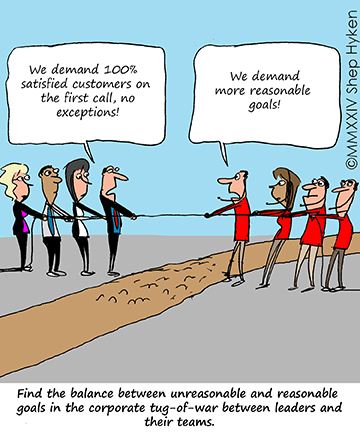
By Shep Hyken
My friend Sterling Hawkins just wrote a great article about the tension between the leadership of a company and the salesforce. Hawkins reports the president of a Fortune 500 company told him, “Tension between the salesforce and leadership is normal. One is always bargaining with the other for more. The sales team wants more time and budget, and the leadership wants more sales.”
That made me think of the tension that is sometimes created between leadership and the customer service team. In the end, it’s mostly because of unrealistic expectations.
It reminds me of an episode of Amazing Business Radio when I interviewed Bill Price, Amazon’s first VP of global customer service, who shared founder and CEO Jeff Bezos’s philosophy about customer service, which was that the experience should be so frictionless that customers wouldn’t need support.
Obviously, a retailer the size of Amazon not needing customer support is unrealistic, but the goal is lofty. Bezos recognized the need for a customer support department and needed someone to run it. In the job interview, Bezos asked Price, “What’s your definition of customer service?” Price answered, “The best service is no service,” and it was apparently the right answer. Price got the job.
In customer service and CX, it’s impossible to be perfect, but that doesn’t mean you shouldn’t try. Still, you must have reasonable expectations. You can’t expect there to never be a problem. You can’t expect a perfect NPS or customer satisfaction rating. But what you can do is create goals, expectations and KPIs that positively impact forward progress.
Here’s another – more generic – example. There are 32 teams in the National Hockey League, and only one will win the Stanley Cup. At the beginning of the season, it’s reasonable for a team’s leadership to say to the players, “Let’s try to win the Stanley Cup!” That’s probably what most teams strive for. What the teams’ leadership doesn’t say is, “You must win every game.”
Creating unrealistic goals and objectives is demotivating. In CX (and just about every other part of a company), leaders should meet with their teams to define success, create realistic goals, include some “stretch goals,” and push their people to continuously improve and be more successful. The right conversations lead to a unified organization headed toward the same goal.
So, what’s a reasonable goal for your customer service teams? Is it higher customer satisfaction scores, higher percentages of first-call resolution, shorter hold times, or something else? Whatever it is, everyone must get in sync and agree on a plan. Then, as a unified team, execute it with a commitment to always doing their best and improving.


